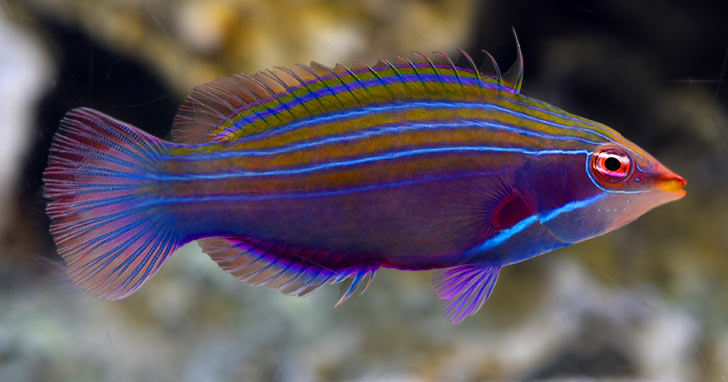
Wrasses for the Small AquariumGood Wrasses for small aquariums
Small aquariums and nano aquariums are more popular than ever with many options and manufacturers available from which to choose. In contrast, finding the right marine fish for the smaller aquarium can be challenging. This is especially true if you are interested in Wrasses since most species are not suitable for smaller aquariums due to their adult size. Before we go any further let’s define “smaller” aquariums. For the sake of this article (and for happy Wrasses) let’s define “smaller” aquariums as setups between 10 and 20 gallons in size. Let’s also take this a step further and define “nano” aquariums as aquariums 10 gallons or less in size. While it can be done, LiveAquaria® does not recommend any of the Wrasse discussed in this article be housed in aquariums less than 10 gallons. However, size is not the only factor to consider since temperament can also strongly influence suitability. For example, the smaller but pugnacious Four Line Wrasse Pseudocheilinus tetrataenia may only grow to 3” but can demonstrate heightened territorial or aggressive behavior towards other fish and Wrasse in a smaller aquarium. Even in a larger aquarium the Four Line Wrasse can potentially bully and harass tankmates Pink-Streaked Wrasse
The Pink-Streaked Wrasse Pseudocheilinops ataenia is one of the best Wrasse species for smaller aquariums due to its diminutive size of only about 2 1/2” when full grown. It’s peaceful demeanor and compatibility with other fish and invertebrates make them a prime candidate. Another great attribute of this little reef-safe gem is its ease of care. The Pink-Streaked Wrasse is also hardy and colorful, boasting several yellow-orange horizontal stripes that run the length of the body starting from just behind the gill cover to the base of the caudal fin (tail). In between the yellow-orange stripes is a variable pink color that transitions to a lighter shade toward the underside of the Wrasse. A bluish gray to lavender color can adorn the chin and belly region and is more prominent in male specimens. “Cute”, “shy,” and “coy” are appropriate terms to describe the Pink-Streaked Wrasse. Their personalities can be described as sheepish and reclusive upon initial introduction into the aquarium. Therefore, it is necessary to have plenty of rock work and corals that provide shelter and structure as well as ample hiding places for the Wrasse to feel secure. As they settle in and become more comfortable in their surroundings, they will be seen more often. An ample aquascape also provides the Pink-Streaked Wrasse with hunting grounds where it can swim in and around in search of food items such as copepods and other small invertebrates that typically inhabit the rock and coral aquascape in established aquariums. A cover or aquarium lid is required since all Wrasses are jumpers. Feeding the Pink-Streaked Wrasse is usually never an issue. They will readily dine on frozen/thawed brine shrimp and smaller Mysis shrimp. Quality sinking marine pellet food is usually accepted over time and makes for a great way to round out the diet. Be sure to add Vita-Chem to the frozen/thawed food a few times a week to ensure fortified nutrition. Possum Wrasse
Possum Wrasses are another great addition to the smaller marine aquarium. Possum Wrasses will fare well with the Pink-Streaked Wrasse. There are three species of Possum Wrasses in the genus Wetmorella – Tanaka’s Pygmy Wrasse or Tanaka’s Possum Wrasse Wetmorella tanakai, the White Banded Possum Wrasse Wetmorella albofasciata, and the Yellow Banded Possum Wrasse Wetmorella nigropinnata. All three species of Possum Wrasse are similar in shape and size, but color and pattern vary slightly between species. Initial body color can range from red to mauve or variants thereof. Juveniles of all Possum Wrasse species tend to be the most colorful with wider bands that narrow as the Wrasse matures. The overall body color may become drab or muted as the Wrasse ages. Both Tanaka’s Possum Wrasse and the White Banded Possum Wrasse have white banding or markings. The Tanaka’s Possum Wrasse has 4 white bands and partial or broken white markings on the head and face. The White Banded Possum Wrasse has 3 white bands with similar head and facial markings. The Yellow Banded Possum Wrasse lives up to its name with two yellow vertical bands similar to the position of the markings on a college regulation football – front and back, behind the eye and before the tail. The Yellow Banded Possum Wrasse will grow to about 3” while the Tanaka’s Possum Wrasse and the White Banded Possum Wrasse will be a half inch or so smaller and measure about 2 1/2” in length. All three species of Possum Wrasse have ocelli, or black “eye” spots on their pectoral, anal and aft section of the dorsal fin. Possum Wrasse diet and care requirements are similar to those of the Pink-Streaked Wrasse. All three Possum Wrasse species can be shy and reclusive when first added to the aquarium, like the Pink-Streaked Wrasse. When possible, the Possum Wrasse and Pink-Streaked Wrasse should be the first fish stocked in the aquarium, ensuring they are first to be established before adding other species of fish. The more aquascape you have in the aquarium, the more secure the Wrasse will feel. The smaller scale Wrasses described above make great additions to any aquarium. If their care requirements are met, you will have success keeping these fascinating and attractive fish that share the same foraging behaviors and activity as their larger cousins. Related Articles
|
|
|


